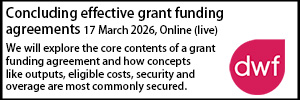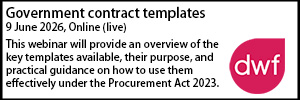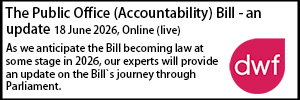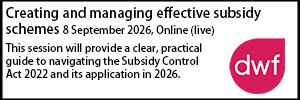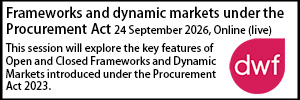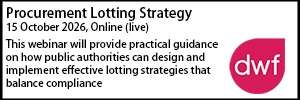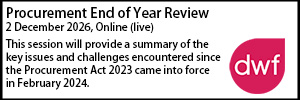Impending Procurement Act: What you need to know
- Details
The Procurement Act 2023 will come into force next week. Liz Fletcher sets out some key actions for contracting authorities and suppliers.
Procurement rules in the UK are on the cusp of significant reform. The latest updates from the Cabinet Office confirm that the Procurement Act 2023 (the “Act”) will officially come into force on 24 February 2025. Despite speculation about potential delays, it now appears that this implementation date will stand firm. The Act introduces extensive changes to public procurement processes, with the overarching aim of simplifying these procedures and enabling greater accessibility for businesses, particularly small and social enterprises, to compete for public sector contracts.
Preparing for the changes
With just a few weeks remaining before the Act takes effect, both suppliers and contracting authorities must take steps to ensure they are ready to navigate the new procurement landscape. The changes present opportunities but also demand meticulous preparation to avoid operational disruptions. Below, we outline the key considerations and actions for contracting authorities and suppliers as the go-live date approaches.
Key actions for contracting authorities
One of the immediate priorities for contracting authorities is onboarding to the Central Digital Platform, the new system designed to centralise procurement processes. The onboarding and registration phase is due to commence by the end of January 2025.
Contracting authorities will need to align their operations with the new regulations. Key preparatory steps include:
- Testing system updates:
Ensure updates to IT systems are thoroughly tested. This includes functionalities for publishing notices, tender documentation, and contract awards under the new rules. - Updating procurement templates:
Revise standard procurement and governance documents. This should account for contracts falling under both the existing regime and the forthcoming Act to avoid procedural inconsistencies. - Incorporating new evaluation criteria:
Update evaluation and award criteria to reflect the Act’s emphasis on broader public benefits, including social value, sustainability, and innovation as well as processes to manage potential exclusions. - Revising timelines:
Assess existing timelines and planning cycles for upcoming projects. Early market engagement will be critical to accommodate the new requirements. - Enhancing transparency in contracts:
Amend contract documentation to incorporate the enhanced transparency obligations and termination rights. This includes ensuring readiness to publish contracts, report performance metrics and managing exit in light of implied termination rights. - Tracking KPIs:
Establish processes to monitor key performance indicators (KPIs) and delivery outcomes for projects awarded under the new framework.
Community of Practice events
The Cabinet Office has been hosting Community of Practice events to equip procurement professionals with the knowledge and tools needed to adapt. These sessions are invaluable for those responsible for implementing the new rules and offer a forum to address uncertainties as the transition progresses.
Key actions for suppliers
Suppliers must also take proactive steps to ensure readiness for the new procurement framework. The Cabinet Office has published updated “how-to” guides designed to help suppliers understand the revised procedures and leverage the opportunities presented by the Act. The guidance highlights several key benefits for businesses, including:
- A streamlined and simplified procurement process.
- Improved accessibility for small businesses and social enterprises.
- Increased focus on social value, sustainability, and innovation in public sector contracts.
For suppliers, preparation should include:
- Familiarising with the new Digital Platform: While the Central Digital Platform is not expected to open for supplier registration until go-live, suppliers should review the available user manuals and video guides to minimise delays when the system becomes operational.
- Reviewing the new procedures: Understand the key procedural changes, such as new tendering routes and award criteria that prioritise public benefit together with the impact updated exclusion processes may have on the supply chain and associated persons. This will help businesses tailor their bids to align with the updated requirements.
- Engaging with updated resources: Explore the Cabinet Office’s resources, which include practical tips for navigating the new rules. For sector-specific concerns, organisations such as the LGA provide additional guidance tailored to suppliers in key industries.
The uncertainty surrounding the Central Digital Platform’s opening date does pose challenges. Suppliers should monitor updates from the Cabinet Office to ensure they are prepared to act promptly once registration begins.
Emphasis on transparency and broader public benefits
The Act’s focus on transparency and public benefits marks a significant shift in public procurement. Contracting authorities must now consider social value, sustainability, and innovation as part of their evaluation criteria. This reflects a broader ambition to ensure that public spending delivers measurable benefits for society as a whole.
To meet these objectives, contracting authorities and suppliers alike must adopt a more collaborative approach to procurement. Early engagement between parties will play a crucial role in ensuring successful project delivery under the new framework.
Available support and resources
Both contracting authorities and suppliers have access to a wealth of resources to support their transition. The Cabinet Office continues to publish guidance, including sector-specific advice, video tutorials, and user manuals. Community of Practice events provide a platform for procurement professionals to share insights and address common challenges.
In addition, the Local Government Association and the National Housing Federation offer tailored resources for local authorities and housing associations, respectively. These organisations are key partners in helping stakeholders navigate the complexities of the new procurement regime.
Conclusion
The Procurement Act 2023 marks a pivotal shift in UK public procurement and it is hoped it will introduce a new era of simplicity, transparency, and accessibility. Whilst there remain a number of areas of uncertainty such as the status of the updated National Procurement Policy Statement, with the go-live date set for 24 February 2025, contracting authorities and suppliers must act now to prepare for the changes ahead.
Liz Fletcher is a commercial partner at Hugh James. Go to the firm’s dedicated public procurement hub, which provides essential updates, practical guidance, and detailed insights into the new regulations.
Sponsored articles
Walker Morris supports Tower Hamlets Council in first known Remediation Contribution Order application issued by local authority
Unlocking legal talent
Lawyer (Planning and Regulatory)
Legal Director - Government and Public Sector
Contracts Lawyer
Locums
Poll
15-07-2026 11:00 am































